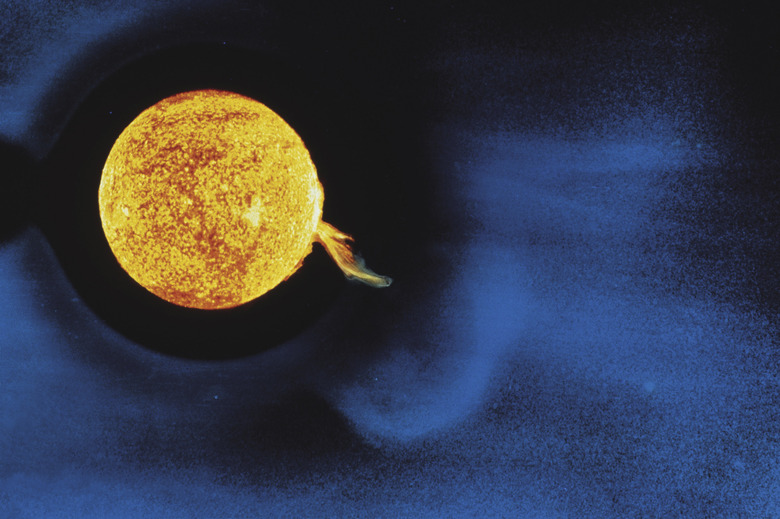What Is The Chemical Composition Of Most Stars?
Our galaxy, the Milky Way, is home to over 400 billion stars of varying brightness. The majority of these stars are described as being main sequence, which means their cores are fusing hydrogen to create helium. The Sun is a main sequence star and its chemical composition mainly consists of hydrogen and helium with trace amounts of other elements.
Hydrogen
Hydrogen
Hydrogen is the most abundant element in the universe and makes up three-quarters of all matter. Stars form when huge amounts of gas and dust collapse under their own gravitational force. The majority of this gas is hydrogen which is the basic fuel that stars use to create energy. During hydrogen fusion, protons (nuclear subatomic particles) are combined in order to create helium. Other by-products are also created in this reaction such as electrons, positrons (antielectron), gamma rays and neutrinos. Neutrinos are ghost like particles that do not interact strongly with matter so these usually escape from the Sun. The collision of the remaining particles with surrounding atoms leads to the heating of the Sun.
Helium
Helium
Helium is the second most abundant element in the universe and is a major component of main sequence stars such as the Sun. Helium accumulates in the core of stars as a result of hydrogen nuclear fusion. Helium accounts of approximately 27 percent of the Sun's mass.
Carbon
Carbon
When hydrogen levels within a star's core depletes, the standard fusion reaction can no longer take place. This leads to a decrease in the amount of energy radiating outwards and the stellar core collapses increasing the temperature and pressure. When the temperature reaches 200 million Kelvin, helium fusion becomes possible. Three helium nuclei fuse to create a single carbon atom.
Oxygen and Other Trace Elements
Oxygen and Other Trace Elements
Fusion of four helium nuclei can be used to create oxygen atoms. This happens in stars that have used up their supply of hydrogen within the core. Further fusion processes can create heavier elements such as silicon, magnesium and sodium. However, the abundance of these elements in most stars is very low and accounts for less than 1 percent of the mass. Fusion within stars can only account for the creation of elements up to the mass of iron. Beyond this, the fusion process uses energy rather than creates it. The remaining heavy elements beyond iron are thought to be forged in the collapse of heavy stars — a process known as supernova.
References
- Universe Today: How Many Stars Are There in the Universe
- Space.com: Main Sequence Stars: Definition and Life Cycle
- National Aeronautics and Space Administration : Chemical Composition of Stars
- Frostburg State University: What Is The Most Abundant Element?
- National Aeronautics and Space Administration : Stars
- Georgia State University: Nuclear Reactions in Stars
- Max Plank Institute for Astronomy: Lecture 7: "Basics of Star Formation and Stellar Nucleosynthesis"
- Lawrence Berkeley Laboratory: The Sun, Hydrogen Bombs, and the Physics of Fusion
- American Chemical Society: Where Do Chemical Elements come From
- National Aeronautics and Space Administration: The Nature of the Sun
Cite This Article
MLA
Markings, Samuel. "What Is The Chemical Composition Of Most Stars?" sciencing.com, https://www.sciencing.com/what-is-the-chemical-composition-of-most-stars-12731968/. 1 March 2014.
APA
Markings, Samuel. (2014, March 1). What Is The Chemical Composition Of Most Stars?. sciencing.com. Retrieved from https://www.sciencing.com/what-is-the-chemical-composition-of-most-stars-12731968/
Chicago
Markings, Samuel. What Is The Chemical Composition Of Most Stars? last modified August 30, 2022. https://www.sciencing.com/what-is-the-chemical-composition-of-most-stars-12731968/
